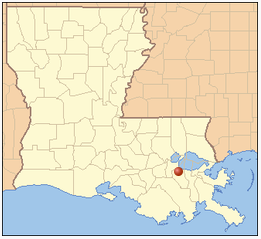| Home | Search | Emissions | Pollutants | About the Database |

Motiva Enterprises (1406), Norco
LDEQ Accident Report
| Accident # | 152855 |
| State Police # | 13-05551 |
| Accident Date | 2013-12-14 |
| Report Date | 2013-12-18 |
| Follow-up Date | 2014-02-12 |
| Follow-up: | Yes |
Pollutants Released
| Pollutant | Duration | Point Source | Greenhouse Gas | Criteria Pollutant | Ozone forming chemical | Amount of Release |
| Carbon Monoxide | 4d 22h 50m | RCCU Flare (EPN 8-84) | NO | YES | NO | 107.5 pounds |
| Nitric Oxide | 4d 22h 50m | RCCU Flare (EPN 8-84) | NO | YES | NO | 19.8 pounds |
| Particulate Matter | 4d 22h 50m | RCCU Flare (EPN 8-84) | NO | YES | NO | 3.7 pounds |
| Sulfur Dioxide | 4d 22h 50m | RCCU Flare (EPN 8-84) | NO | YES | NO | 25.8 pounds |
| Volatile Organic Compounds (VOCs) | 4d 22h 50m | RCCU Flare (EPN 8-84) | NO | NO | YES | 19.7 pounds |
| Hydrogen Sulfide | 4d 22h 50m | RCCU Flare (EPN 8-84) | NO | NO | NO | BRQ |
Accident Classified As: Below Reportable Quantity (BRQ)
Cause of Problem: Weather
On December 14, 2013, the three-hour rolling average for the amount of hydrogen sulfide to the Residual Catalytic Cracking Unity (RCCU) Flare exceeded its 162 ppm limit. The hydrogen sulfide to the RCCU Flare continued to increase exceeding the monitoring capabilities of the flare's hydrogen sulfide analyzer. As a result, Operations monitored the hydrogen sulfide concentrations by sampling the flare header. Hydrogen sulfide concentrations fluctuated as troubleshooting occurred. Several contributing factors were identified. One of these factors was that the cold weather was affecting some of the valve bodies by allowing small quantities of H2S to leak through a close valve during lower ambient temperatures. In addition, it was found that the RCCU flare knock out drum and the maintenance drop out drum were contaminated with H2S as a result of recent shutdown activities.
Discharge Preventable - Yes
Notes/Remedial Actions
Immediately, operations began a systematic search for the sources of H2S routed to the flare. This search identified all potential H2S intrusion points within the RCCU and RGHT Units, and prioritized those most likely contributing to the elevated H2S in the Flare system. Next, they flushed the RCCU elevated flare knock out drum and the maintenance drop out drum. Unit rate increases were delayed and unit feed rates were maintained during the duration of the incident. To prevent recurrences, the refinery will evaluate the need to upgrade/replace additional RV and HIC valves that are routed to the RCCU Elevated Flare header in order to prevent leakage during cold weather. Additionally, it will evaluate the need to apply weather shields and/or steam lances to valves affected by cold weather. Note: the 60-day report states: "Data gathering and calculations confirm no reportable quantities were exceeded during the release. However, the maximum pound per hour permit limit for sulfur dioxide was exceeded during this incident," and "The hydrogen sulfide to the the RCCU Flare exceeded the monitoring capabilities of the flare's hydrogen sulfide analyzer." Hence, the amount of hydrogen sulfide released (and not oxidized to SO2) is unknown.

Connect With Us: